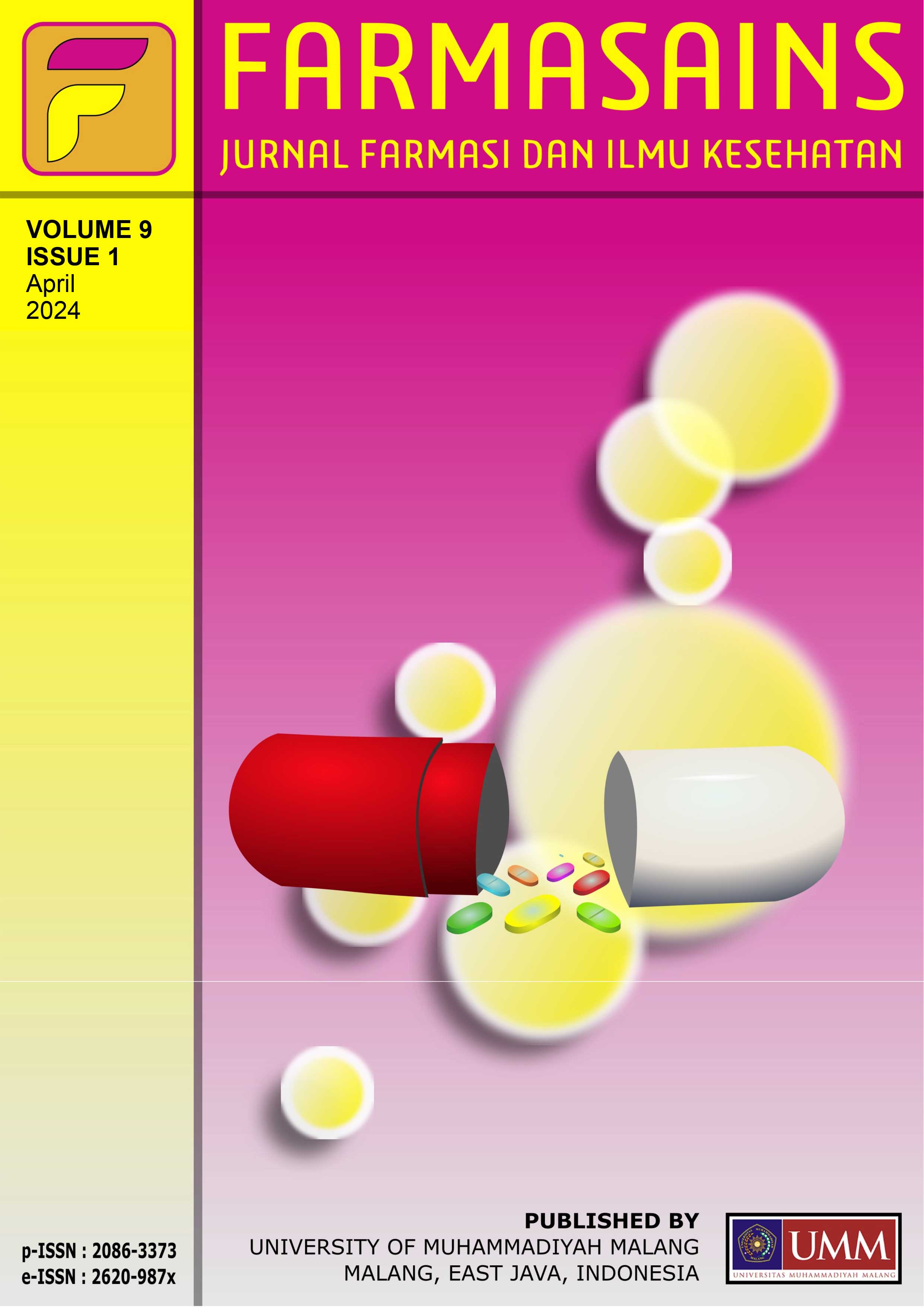Organoleptic and Chemical Properties of SERANGI Herbal Drink: A Blend of Lemongrass (Cymbopogon nardus L.) and Holy Basil (Ocimum sanctum L.) as Immune Booster.
DOI:
https://doi.org/10.22219/farmasains.v9i1.33968Keywords:
ability antibacterialAbstract
Herbal drinks have therapeutic and refreshing properties. Some plethora of botanicals are used as herbal drink ingredients, including simplicia from lemongrass (Cymbopogon nardus L.) and holy basil (Ocinum sanctum L.). This research was performed to assess the organoleptic and chemical characteristics of lemongrass and holy basil simplicia herbal drink named Serangi. The research underwent two phases: organoleptic testing in the first stage and chemical analysis in the second stage to evaluate pH, vitamin C levels, and total phenols in Serangi herbal drink. Three repetitions had been performed to gain data mean values and standard deviation before being analyzed using General Linear ANOVA model (GLM) on the Minitab 20 software. Results revealed panelists' preferences for F3 in terms of color, aroma, and taste, with ratings of 4.12, 4.02, and 4.05, respectively. All Serangi drink samples met the pH requirements, falling within the 3-8 range, where F3 exhibited the highest vitamin C content of 1.224% and total phenol content of 122.10 mg GAE/100g/ml. Serangi herbal drink is rich in vitamin C and secondary metabolites and it offers immune-boosting benefits.
Downloads
References
Agustiarini, V., Fauziyah, F., & Wijaya, D. P. (2020). Pengaruh Pemberian Variasi Gula Pasir Pada Minuman Daun Pegagan (Centella asiatica (L.) Urban) Terhadap Organoleptik dan Kadar β-Karoten. Jurnal Penelitian Sains, 22(3), 162. https://doi.org/10.56064/jps.v22i3.598
Ariani, F., & Muhsin, L. B. (2023). Analisis Kadar Vitamin C Pada Buah Jeruk Nipis (Citrus aurantifolia Swing.) dan Jeruk Manis (Citrus sinensis) menggunakan Titrasi Iodometri. Biocity Journal of Pharmacy Bioscience and Clinical Community, 1(2), 73–80. https://doi.org/10.30812/biocity.v1i2.2811
Barodia, K., Pragnya, S., Kanwal, A., Menon, A., Rajeevan, R., Rukade, A., Udaya, R., Shenoy, K., Prabhu, C., Sharma, V., Divya, K. P., Sumalatha, S., Nayak, Y., & Kumar, N. (2022). Journal of Ayurveda and Integrative Medicine Effect of Moringa oleifera leaf extract on exercise and dexamethasone- induced functional impairment in skeletal muscles. Journal of Ayurveda and Integrative Medicine, 13(1), 100503. https://doi.org/10.1016/j.jaim.2021.07.019
Cahyadi, W., & Widiantara, T. (2018). Penambahan Konsentrasi Bahan Penstabil Dan Sukrosa Terhadap Karakteristik Sorbet Murbei Hitam. Pasundan Food Technology Journal, 4(3), 218. https://doi.org/10.23969/pftj.v4i3.649
Dwiloka, B., Rahman, F. T., & Mulyani, S. (2022). Nilai pH, Viskositas dan Hedonik Sari Buah Jeruk Manis dengan Penambahan Gelatin Tulang Ikan Bandeng. AgriHealth: Journal of Agri-Food, Nutrition and Public Health, 2(2), 107. https://doi.org/10.20961/agrihealth.v2i2.59482
Farid Hossain, M. (2015). Nutritional Value and Medicinal Benefits of Pineapple. International Journal of Nutrition and Food Sciences, 4(1), 84. https://doi.org/10.11648/j.ijnfs.20150401.22
Irfan Fadhlurrohman, Ridho Maulaeni, & Asmaradika Cahya Tirta. (2023). Fortifikasi Serai (Cymbopogon citratus) pada Produk Susu Fermentasi sebagai Potensi Pangan Fungsional: Kajian Literatur. Prosiding Seminar Nasional Pembangunan Dan Pendidikan Vokasi Pertanian, 4(1), 418–428. https://doi.org/10.47687/snppvp.v4i1.666
Mahato, D. K., Kargwal, R., Kamle, M., Sharma, B., Pandhi, S., Mishra, S., Gupta, A., Mahmud, M. M. C., Gupta, M. K., Singha, L. B., & Kumar, P. (2022). Ethnopharmacological properties and Nutraceutical potential of Moringa oleifera. Phytomedicine Plus, 2(1), 100168. https://doi.org/10.1016/j.phyplu.2021.100168
Pawar, S. G., & Kamble, V. M. (2015). Asian Journal of Multidisciplinary Studies some antiallergenic medicinal plants . 17–19.
Putri, C. A. (2019). Uji Kandungan ß-Karoten dan Uji Daya Terima pada Pembuatan Minuman Instan Daun Kemangi (Sanctum Ocimum L) dengan Jahe (Zingiber Officinale). Jurnal Skripsi , 1(1), 2–41.
Ryadha, S.R., Aulia, N., & Batara, A. (2021). Potensi Rempah-Rempah sebagai Minuman Fungsional Sumber Antioksidan dalam Menghadapi Pandemi Covid-19. Jurnal ABDI, 3(1), 30–42.
Singh, A. K., Rana, H. K., Tshabalala, T., Kumar, R., Gupta, A., Ndhlala, A. R., & Pandey, A. K. (2020). Phytochemical, nutraceutical and pharmacological attributes of a functional crop Moringa oleifera Lam: An overview. South African Journal of Botany, 129, 209–220. https://doi.org/10.1016/j.sajb.2019.06.017
Wahid, A. R., Ittiqo, D. H., Qiyaam, N., Hati, M. P., Fitriana, Y., Amalia, A., & Anggraini, A. (2020). PEMANFAATAN DAUN KEMANGI (Ocinum sanctum) Sebagai Produk Antiseptik Untuk Preventif Penyakit Di Desa Batujai Kabupaten Lombok Tengah. SELAPARANG Jurnal Pengabdian Masyarakat Berkemajuan, 4(1), 500. https://doi.org/10.31764/jpmb.v4i1.2841
Wulansari, D., Rahmi, S. L., Fiardilla, F., & Ningsih, S. (2023). Organoleptik Test Effervescent Powder Pulai Leaves (Alstonia scholaris (L.) R.BR. Jurnal Pengembangan Agroindustri Terapan, 2(1). https://doi.org/10.25181/jupiter.v2i1.2878
Yanti, F., Surhaini, & Suseno, R. (2022). Formulasi Teh Herbal Berbasis Serai (Cymbopogon citratus), Rosela (Hibiscus sabdariffa Linn.), dan Jahe (Zingiber officinale Rosc.). Jurnal Teknologi Hasil Pertanian, 1(1), 1–10.
Downloads
Published
How to Cite
Issue
Section
License
Copyright (c) 2024 Ambar Fidyasari, Ayu Ristamaya Yusuf, Nafila Nada Dzikri

This work is licensed under a Creative Commons Attribution 4.0 International License.
Authors who publish with this journal agree to the following terms:
a. Authors retain copyright and grant the journal right of first publication with the work simultaneously licensed under a Creative Commons Attribution License that allows others to share the work with an acknowledgement of the work's authorship and initial publication in this journal.
b. Authors are able to enter into separate, additional contractual arrangements for the non-exclusive distribution of the journal's published version of the work (e.g., post it to an institutional repository or publish it in a book), with an acknowledgement of its initial publication in this journal.
c. Authors are permitted and encouraged to post their work online (e.g., in institutional repositories or on their website) prior to and during the submission process, as it can lead to productive exchanges, as well as earlier and greater citation of published work (See The Effect of Open Access).













